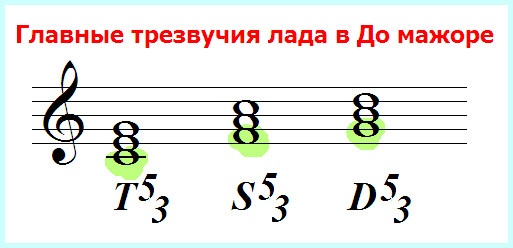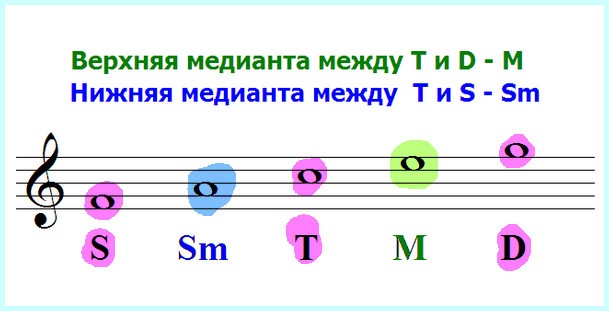
The main steps of the mode: tonic, subdominant and dominant
Contents
There are three special steps in the major or minor scale – the first, fourth and fifth. These steps are considered the main ones, and they are even called in a special way: the first is called the tonic, the fourth is the subdominant, and the fifth is the dominant.
In major, these steps are abbreviated with capital letters T, S and D. In minor, they are written with the same letters, only lowercase, small: t, s and d.
For example, in the key of C major, such main steps will be the sounds DO (tonic), FA (subdominant) and SALT (dominant). In the key of D minor, the tonic is the sound RE, the subdominant is the sound S, and the dominant is the sound LA.

EXERCISE: determine the main steps in the keys of A major, B-flat major, E minor, F minor. Do not forget that each key has its own key signs – sharps and flats, and they must be taken into account when you name the sound corresponding to the desired degree.
SHOW ANSWERS:

- A major – tonality with three sharps (fa, do, sol), according to the literal designation – A-dur. The main steps are LA (T), RE (S), MI (D).
- The tonality of B-flat major is flat (B-dur), it has two signs (B-flat and E-flat). Tonic – sound SI-FLAT, subdominant – MI-FLAT, dominant – FA.
- E minor (e-moll) – gamma with one sharp (f-sharp). The main steps here are the sounds MI (t), LA (s) and SI (d).
- Finally, F minor (f-moll) is a scale with four flats (si, mi, la, re). The main steps are FA (t), B-flat (s) and DO (d).
[collapse]
Why are these stages called the main ones?
Sounds in harmony are divided, as it were, into three teams, or, to put it another way, they are divided into three groups. Each team of sounds performs its strictly defined function, that is, a role in the development of a musical work.
Tonic, subdominant and dominant are the “leaders” or “captains” of these three teams. We can easily identify all members of each group if we build a triad on each of the main steps – the first, fourth or fifth.
If, for example, we construct the triads we need in C major, we will get the following: triad from the tonic – DO, MI, SOL; triad from the subdominant – FA, LA, DO; triad from the dominant – SOL, SI, RE. Now let’s see what specific steps were included in each of the teams.

So, the tonic “team” or, more correctly, the tonic group includes the first, third and fifth steps. You may remember that these steps are also called sustained steps and together make up a tonic triad.
In the subdominant group or in the subdominant team there were such steps: fourth, sixth and first. This triad will be called subdominant. By the way, you may have noticed that the first step is included in two teams at once – in the tonic (she is the leader there) and in the subdominant one. This should not be surprising, just this stage is bifunctional (dual), that is, it can take turns playing one role or another, depending on the environment in which it is located.
We will include the fifth, seventh and second steps in the dominant group. The triad of this command is also called the dominant triad. And it also has a bifunctional step – the fifth, that is, the dominant itself, which can both work in its group and help the tonic, depending on what the composer prescribes for it.
The triads on the main steps that we have built are called the main triads of the mode. They have all the sounds of a tonality. And another interesting feature of them is that in major keys the main triads are large, that is, major; in minor keys they are small, that is, minor. Thus, the main triads not only concentrate the main forces of tonality in themselves, but also perfectly characterize its mode – major or minor.
What functions do these groups and steps perform?
Tonic performs the function of stability, tranquility. Tonic triad sounds are suitable for ending a song or a piece for some instrument. This is a very important function, because without it we would never understand that the work was over, and the end had come, we would have been sitting further in the concert hall, waiting for the continuation. In addition, the tonic always relieves tension that comes from other functions.
To the subdominant can be called the engine of musical development. Its use is always associated with movement, with the departure from the tonic. Very often, transitions to other keys, that is, modulations, are made through the subdominant. Movement along the sounds of the subdominant accumulates tension.
Dominant – a force that is opposite to the subdominant. She is also very mobile, but her tension is much greater than the subdominant, it aggravates the situation so much that an urgent “search for a way out”, an urgent resolution is certainly required. Thus, if the subdominant leads us away from the tonic all the time, then the dominant, on the contrary, leads to it.
What are the other steps called?
All other stages, which are not related to the main ones, are called secondary. These are the second, third, sixth and seventh sounds in the scale. And yes, they also have their own special names.
Let’s start with the steps that are closest to the tonic. This is the seventh and second. They are called introductory steps. The fact is that they are unstable, and are very drawn to the tonic, as a rule, they are resolved into it and therefore, as it were, introduce us to the most important sound of the tonality, serve as a kind of conductor. The seventh step is called the lower introductory sound, and the second – the upper introductory.

The third and sixth steps are called mediants. From the Latin language the word “media” is translated as “middle”. These steps are an intermediate link, a midpoint on the way from the tonic to the dominant or to the subdominant. The third step is called the upper mediant (denoted as M), and the sixth is called the lower mediant or submediant (its abbreviation is Sm).

Knowing the main steps and their functions, as well as the idea of how the side steps sound, helps a lot to navigate the key – to hear the built chords, intervals in it, quickly select the accompaniment, correctly build phrasing and dynamics during performance.
Finally, I would like to once again draw your attention to the fact that the main steps and stable steps are different things. The main steps are the first, fourth, fifth, and the stable ones are the first, third and fifth. Try not to confuse them!
Video: how the main steps sound in the keys of C major and A minor





